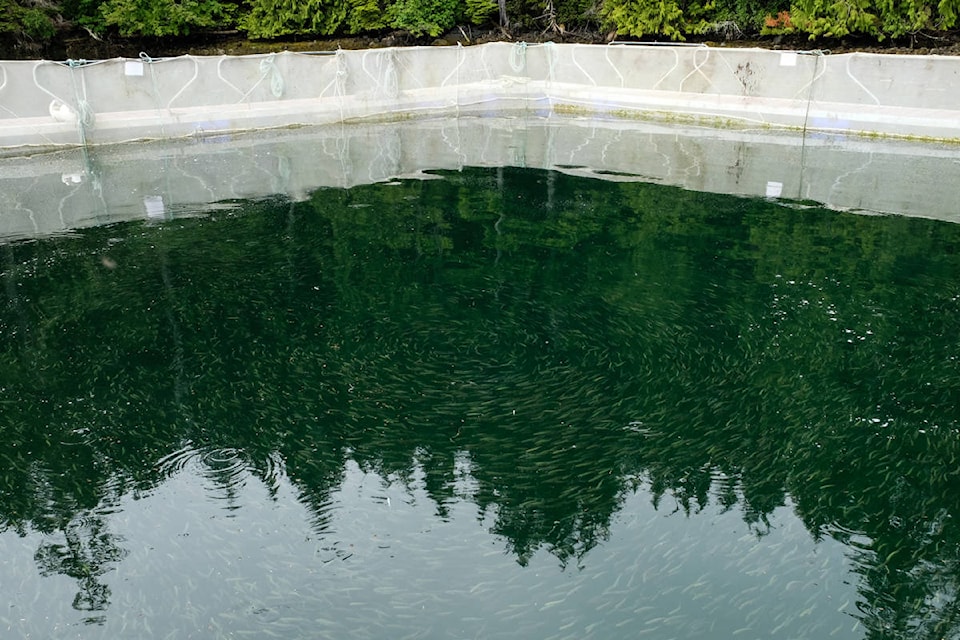Debbie Anderson stands on the floating dock at Quatsino Lodge, waiting for the barge. Behind her, a 25-foot-deep net pen, anchored in each corner and lashed to the dock, bobs in the still water. Rain spatters on a dreary Monday morning. Volunteers bustle around the dock getting ready.
“The babies are coming, the babies are coming!” Anderson calls. The barge arrives with three trucks holding 52,000 salmon smolts between them. “LIVE FISH” is emblazoned on the boxes.
These chinook — the spawn of 14 females – had been set aside at the Marble River Hatchery for special treatment that increases their survival rate by three per cent.
“It doesn’t sound like a lot, but to a salmon, that’s a big deal,” Anderson says.
The rest of the 500,000 fish are released at the hatchery to find their own way to the ocean. But these smolts – older than fry, but not yet adult fish – are hand-delivered to an ocean net pen on the other side of the estuary.
In that body of water, where fresh and salt water mix, is where baby fish are most vulnerable. They get sluggish as they acclimatize to salt water and are easy prey for birds. A single family of merganser ducks can can eat 100,000 smolts in one season. These 10 per cent are taken by trucks and a barge straight to the salt water, and then get a month to grow up in safety before they’ll finally be wild.
The barge is parked next to the pen, where volunteers are ready with buckets and brooms. A six-inch-wide hose was fitted to a valve in the LIVE FISH box.
“Ready down there?” Ray Volk calls from his perch on the truck. He’s a Quatse River Hatchery staff member who helps Marble River with the fish transfer.
“Born ready!” Anderson answers. She’s crouched at the edge of the pen, holding the open end of the hose. Volk lifts the gate and three-inch salmon smolts surge down the hose into their new home.
The disoriented, stressed salmon swim in circles, mimicking their holding pens back at the hatchery. They’ll need a couple of hours to realize how much space they now have.
The Marble River Hatchery, run by a crew of over 100 volunteers, has been working to restore chinook stock in the Marble River since 1981. A local logger, Bill Dumont, found out that there used to be 10,000 chinook in the river. The year he started the hatchery, there were 500.
“If we’re going to be part of the problem, let’s also be part of the solution,” he used to say.
By 1997, Anderson had taken on a volunteer managing role at the hatchery. It was autumn, she was standing on a bridge, and saw fish swimming upstream in the river below.
| Chinook smolts are gently shoved out of their transport box, down a hose and into an ocean pen. (Zoe Ducklow) |
“Bill! Bill, there’s fish!” she called out.
“He didn’t believe me, but then he looked and said, ‘Debbie, there’s fish! I don’t think you understand, there’s fish!’ ” “Seventeen years. That’s how long it takes to restock a river,” Anderson said.
Now, after 39 years later, between 5,000 and 7,000 chinook swim back up the Marble River to spawn.
“If we get to 10,000, I guess it will be time to close the hatchery. But then again, if we keep fishing, maybe we need to keep helping,” Anderson mused.
Marble River flows north into Quatsino Sound on Vancouver Island’s west coast, drawing from a 518-square-kilometre watershed. It was formerly used as a water source for Island Copper Mine in Port Hardy, closed in 1995, and the pulp mill in Port Alice, which ceased operating in 2015.
Water levels were low when those operations were using millions of cubic metres of water a day, but have since rebounded to the point where fish ladders the hatchery had installed are unnecessary.
| Releasing salmon smolts into their all-inclusive resort in Quatsino Sound. (Zoe Ducklow) |
Anderson and the other volunteers, including staff from the Quatse Hatchery, stand and watch the fish, mesmerized as their colour comes back, and by the swirls and patterns they form, swimming in various clockwise groups.
With luck, these 52,000 smolts will add to the number of returning salmon in the Marble, and the hatchery team will be back next year, doing it all over again.
Do you have something to add to this story or something else we should report on? Email:
zoe.ducklow@blackpress.ca.
Like us on and follow us on .



